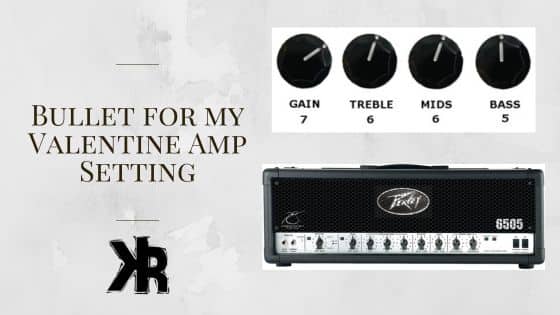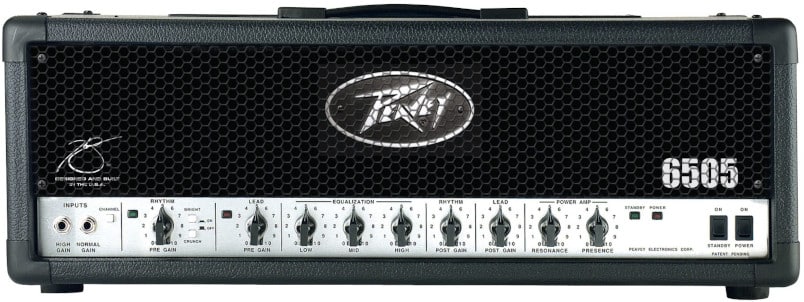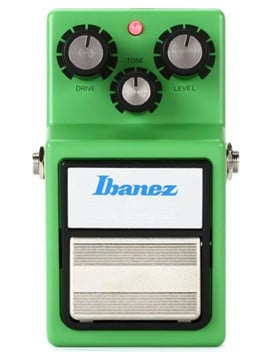Table of Contents
Bullet For My Valentine is a heavy metal band hailing from Wales. They have stolen the hearts of metal enthusiasts worldwide with their unique sound.
Their guitar tone uses heavy distortion and has excellent melodic undertones. But one thing is guaranteed, it’s a sought-after sound by many aspiring guitarists.
Achieving this tone, however, is not just about having the right gear. It’s also about dialing in the perfect amp settings to replicate the band’s distinctive sound.
In this Killer Rig guide, we’ll delve into the world of Bullet For My Valentine’s sound, exploring not only the gear they use but also the precise amp settings that help them create their signature tone.
This way, you can get as close as possible to their sound, right in your very own bedroom or beyond. So let’s dive into the world of Bullet For My Valentine’s amp settings and sounds.
What is the Bullet for My Valentine Sound?
Bullet For My Valentine’s sound is a powerful blend of melodic metalcore and heavy metal. Their guitar tone is a sound that’s aggressive and biting, yet smooth and melodic. It’s a sound that’s as original as the band itself.
You should pay attention to how the powerful, distorted guitar riffs and the melodies that make up their song interact in order to fully understand the Bullet For My Valentine sound.
But it’s not just about cranking the gain up to nearly max. No, this will be a bass-filled mess! They also use a balance of treble, mids, and bass to shape their sound, creating a tone that’s as complex as it is compelling.
Some quick BFMV amp settings are:
- Gain: 6
- Treble: 6
- Mids: 7
- Bass: 5
- Presence: 6
Understanding how each component contributes to the overall tone is key to creating this sound. For instance, the gain adds the significant distortion that characterizes the band’s sound.
The treble adds brightness and clarity, while the mids and bass add depth and warmth. Each of these elements needs to be carefully balanced to achieve the Bullet For My Valentine sound.
Not sure what amp settings actually do? Check out my guide to amp controls and settings to get up to speed!
Bullet For My Valentine Amp Settings
Achieving the Bullet For My Valentine sound starts with understanding the amp settings. If you don’t know what they do, then this will be a hard tweaking lesson! Let’s break down each of these elements.
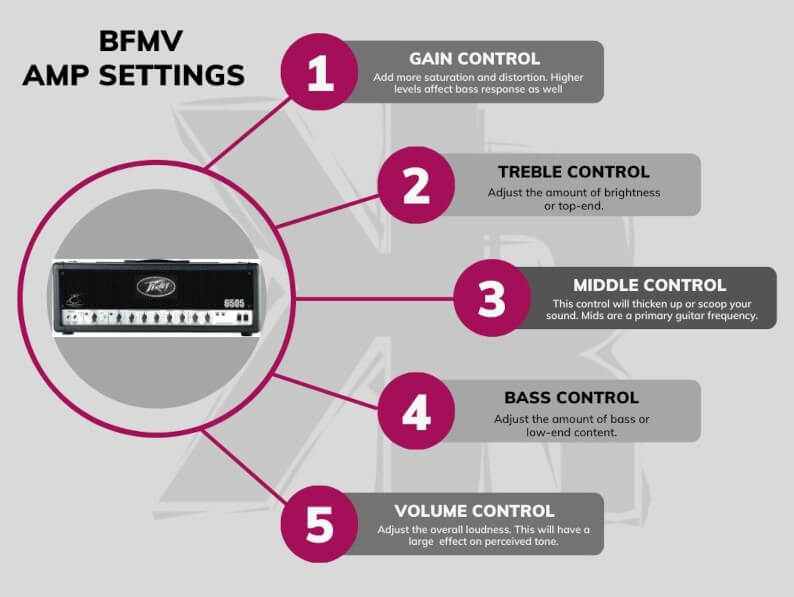
Gain Control
The gain control is your first stop. It’s responsible for the level of distortion in your sound, and Bullet For My Valentine is known for their heavily distorted tone. Start with a high gain setting, around 6 or 7.
But remember that the right amount of gain can vary depending on your specific gear. Too much gain can muddy your sound, so it’s crucial to find a balance that gives you heavy distortion while maintaining clarity.
Treble, Mids, and Bass
Next, we move on to the equalizer controls: treble, mids, and bass. These controls shape the character of your sound. For the Bullet For My Valentine tone, start with the treble at around 6. This gives your sound the brightness and clarity that’s characteristic of their music.
The mids control adds body and thickness to your sound. Set this around 6 or 7 to start with, but feel free to adjust to taste. Remember, the mids can add warmth to your sound, but too much can make it sound boxy.
The bass control adds depth and fullness to your sound. Start with this control set to around 5. This should give your tone a solid foundation without overpowering the other elements.
Presence
The presence control is like the secret sauce in your tone. It adds a certain sparkle and clarity to the high frequencies. For the Bullet For My Valentine sound, set this control to around 6. This should give your tone a nice shine without making it sound harsh.
Check out our Meshuggah amp settings after this guide!
Popular Bullet For My Valentine Songs and Their Amp Settings
Once you’ve got a handle on the general amp settings for the Bullet For My Valentine sound, it’s time to dive into some of their most popular songs.
Each song has its unique nuances, and adjusting your amp settings accordingly can help you capture the essence of each track.
Tears Don’t Fall
One of the band’s most iconic songs, Tears Don’t Fall, showcases their signature blend of melodic elements and heavy distortion. Here are some suggested amp settings:
- Gain: 7
- Treble: 7
- Mids: 6
- Bass: 6
- Presence: 6
These settings should give you a thick, heavy tone with plenty of bite, perfect for the song’s powerful riffs and soaring melodies.
Check out these Deftones amp settings!
Your Betrayal
Your Betrayal is another fan favorite, known for its aggressive guitar work. Try these settings to capture the song’s intense energy:
- Gain: 7
- Treble: 6
- Mids: 5
- Bass: 6
- Presence: 7
These settings should give you a more aggressive tone, with plenty of distortion and a fuller sound in your power chords.
Get Dimebag Darrell amp settings here.
All These Things I Hate (Revolve Around Me)
For a more melodic track like All These Things I Hate, you might want to adjust your settings slightly to capture the song’s more nuanced tones:
- Gain: 6
- Treble: 6
- Mids: 7
- Bass: 5
- Presence: 5
These settings should give you a balanced tone that can handle the song’s dynamic shifts between softer verses and heavier choruses.
Gear Used by Bullet For My Valentine
While amp settings play a crucial role in achieving the Bullet For My Valentine sound, the gear used by the band is equally important. The band’s choice of guitars, amps, and pedals significantly contributes to their crushing tone.
Guitars
Bullet For My Valentine’s guitarists, Matthew Tuck and Michael Paget, have been known to use a variety of guitars over the years. They have a preference for guitars with humbucker pickups for their ability to handle high gain settings without excessive noise.
Tuck often uses a Gibson Les Paul Custom, while Paget is known for his use of ESP guitars, particularly the LTD MP-600. This is his signature guitar.
Amps
The band’s heavy, distorted tone is largely due to their choice of amps. They have been known to use Peavey 6505+ heads, which are renowned for their high gain capabilities and thick, saturated tones.
These amps are a staple in the metal genre and are a key component of the Bullet For My Valentine sound. They have also been using Kemper Profilers for live performances.
Pedals
Bullet For My Valentine also uses a variety of pedals to shape their sound. Overdrive and distortion pedals, such as the Ibanez Tube Screamer and the MXR Zakk Wylde overdrive, are used to push their amps into heavier distortion.
They also use delay and reverb effects to add depth and dimension to their sound.
Learn more about metal amp settings here!
Bullet For My Valentine Tone Setting Tips
- Experiment with Gain: Bullet For My Valentine uses a lot of gain in their sound, but too much can make your tone muddy. Experiment with different levels of gain to find the right balance of distortion and clarity.
- Adjust EQ Settings: Most players are afraid to tweak the treble, mids, and bass controls. These settings can significantly affect your tone and are there for a reason. So take the time to find the right balance.
- Use the Right Pedals: Overdrive, distortion, delay, and reverb pedals can all contribute to the Bullet For My Valentine sound. Experiment with different pedals to see how they affect your tone.
- Try Different Guitars: Different guitars can produce very different tones, even with the same amp settings. If possible, try out different guitars to see which ones work best for the Bullet For My Valentine sound.
- Don’t Forget the Volume Knob: Your guitar’s volume knob can be a powerful tool for shaping your tone. Try rolling back the volume for cleaner tones and cranking it up for heavier parts.
- Experiment with Pickup Selection: The choice between using the neck or bridge pickup can drastically change your tone. Experiment with both to see which one suits the sound best.
- Consider String Gauge: Heavier string gauges can give you a thicker, fuller sound. If your guitar can handle them, it’s worth trying this out. It can be quite beneficial for achieving the right tone.
Remember, these are just tips. The key to achieving the perfect tone is experimentation. Don’t be afraid to try different things and see what works best for you.
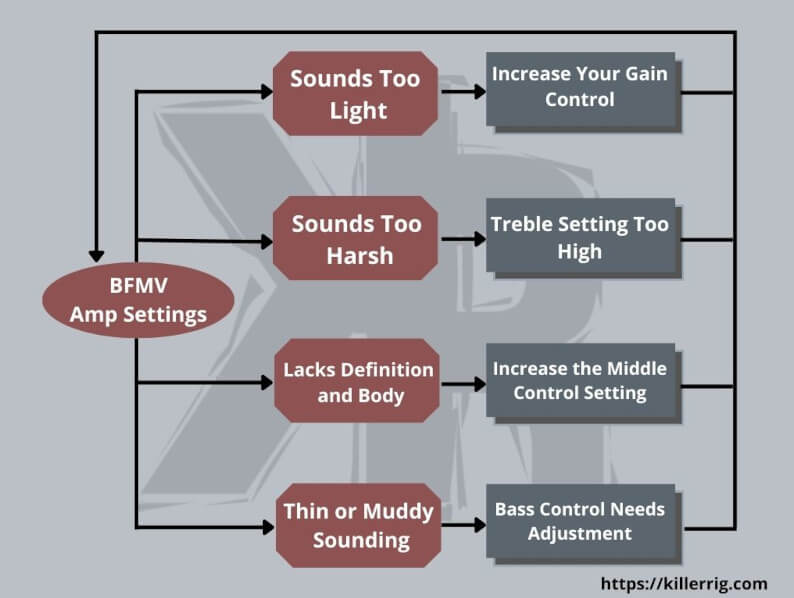
Conclusion
Achieving the Bullet For My Valentine sound is a journey of exploration and experimentation. It’s about dissecting the band’s tone, the equipment used, and the amp settings that bring their sound to life. But if you can find your own path to that sound, then bonus!
The settings and gear we’ve discussed are just starting points. Don’t be afraid to tweak these settings, try different gear, and make the sound your own.
With a bit of patience and a lot of practice, you’ll be able to capture the essence of the Bullet For My Valentine sound and perhaps even add your own unique twist to it.
FAQ
Do I need the same gear to get the Bullet For My Valentine sound?
While having similar gear can help you get closer to the Bullet For My Valentine sound, it’s not necessary to have the exact same equipment.
You can achieve similar tones with different gear by understanding how each piece of equipment contributes to the overall sound and adjusting your settings accordingly.
How important are the amp settings in the Bullet For My Valentine sound?
Amp settings play a crucial role in achieving the Bullet For My Valentine sound. The band’s signature tone is a result of a careful balance of gain, treble, mids, bass, and presence.
But every amp is different, so understanding how to adjust these settings with yours is key to getting their sound.

